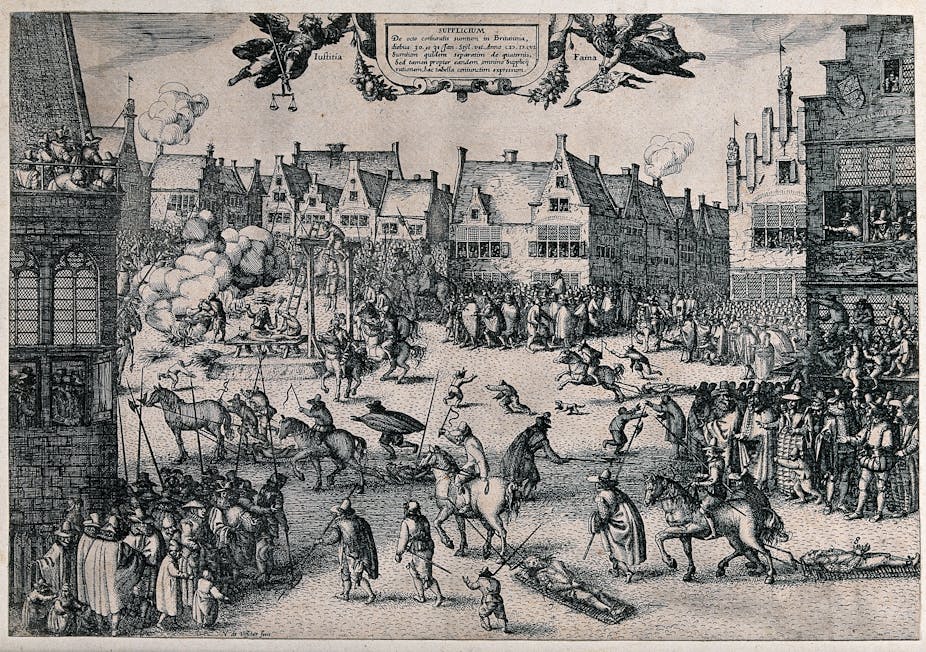The compelling BBC series Gunpowder, which tells the story of the 1605 Catholic Gunpowder Plot against King James I of England, has sparked much discussion about the gruesome scenes in its early episodes. And the dramatised public executions might well be unsettling for a 21st-century audience. We are unused to seeing a woman stripped naked in public, then crushed to death; or a young man being hung, drawn (his insides ripped out) and then quartered (legs and arms removed with an axe).
Complaints about the explicit level of violence have been matched by useful reminders by academics that this was indeed a violent society in which gruesome acts were commonplace. Meanwhile, others have argued that assuming bloodcurdling violence was universal is not a useful way to understand 17th-century society.
So what was really behind the apparent bloodthirstiness of Jacobean England?
Fact or fiction?
Historical accuracy is often questioned in dramas such as Gunpowder, so it is worth asking first whether such horrors actually happened at all. The penalty (crushing to death) suffered by the fictitious Dorothy Dibdale for priest harbouring in Gunpowder was not completely unknown. It actually happened to Margaret Clitherow, who was sentenced to the punishment for harbouring Catholic priests and is now recognised as a saint by the Catholic Church. It is worth noting, however, that she was an Elizabethan, not a Jacobean, and died almost 20 years prior to the Gunpowder Plot.
But this particular form of execution certainly wasn’t commonplace. It was imposed on Margaret Clitherow because she refused to enter a plea, as Dibdale did in Gunpowder. The more typical punishment for (male) Catholic priests was to be hung, drawn and quartered. Those helping missionary priests also faced the prospect of death, although women traditionally were more likely to face burning.
In Gunpowder, before the young Jesuit is hung, drawn and quartered, the authorities declare that he has been “tried and condemned as a heretic”. But the reality was actually quite different. The Protestant state was adamant that the Catholics they put to death were guilty of “treason” – which is why he was not burned at the stake as a heretic.

These might seem arcane points, but the form of death did matter. However horrific it seems to us, this was not “mindless” violence, but deeply symbolic and structured according to contemporary understandings of justice. Priests were convicted of treason, and treated in the same way as other traitors – the threat they presented to the body politic being effaced in the dismembering of their own physical body, while the public display of body parts was used to deter others.
No accident
Other forms of religious violence in the early modern period, including those that were not imposed directly by the authorities – from the slaughter of Protestants by Catholics in the French Wars of Religion, to the iconoclasm of Parliamentarian troops in the British Civil Wars likewise had an internal structure and logic. The targets and victims of this violence were not accidental.
Of course, the state’s interpretation of physical penalties could also be challenged. Catholics sought to overturn the Protestant interpretation of these executions. For them, their coreligionists died as martyrs, not traitors. Their reported courage in the face of the state-sponsored brutality was proof of the righteousness of their cause.
Similarly, the Protestant government of the time operated with an awareness of the potential danger of public executions. The martyr narrative of Margaret Clitherow, written by a seminary priest she protected, suggests that the authorities were reluctant to impose this death on her. Executions could be rowdy affairs and forms of entertainment, but men and women attended them for a variety of reasons: some to gawp and jeer, others to bear witness. Staging a public execution risked inspiring conversions to the victim’s cause.
Perhaps more important is the sense Gunpowder offers of the dilemmas that people of the past sometimes faced and the various ways in which they made sense of the times they lived in.
In Gunpowder, it is refreshing to see a question mark placed over older blithe acceptance of the inevitable triumph of Protestantism in England (or Britain) – we see King James’s councillors seriously concerned about the regime’s survival – and the often unstated assumption that “sensible” England, unlike its near neighbours, largely avoided the sorts of violence the religious changes of the period provoked. In fact, there were numerous plots against James after he succeeded the childless Elizabeth I – and his son, Charles I, would go on to lose his head as part of a long and bloody civil war.

The thought that our ancestors lived in a violent and bloody world and were the perpetrators of such acts of violence might be uncomfortable partly because it forces us to revisit our sense of ourselves and where we come from. It certainly suggests how violence begets violence.
Interestingly, the series depicts violence by the Protestant state against Catholics before it gets to the intended violence of Catholics against that state. After all, the Catholic Gunpowder Plot aimed to obliterate the king and the majority of the ruling elite of Jacobean England. Each took place in reference to and in answer to the other.
The level of state sponsored violence depicted in Gunpowder may not have been the everyday experience of all of the monarch’s subjects, but people lived in the knowledge of its possibility. And in many states, that remains as true today.

